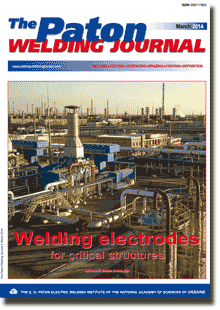| 2014 №03 (08) |
DOI of Article 10.15407/tpwj2014.03.09 |
2014 №03 (01) |

The Paton Welding Journal, 2014, #3, 49-52 pages
REASONS OF STRESS CORROSION FAILURE OF ERECTION GIRTH JOINT OF MAIN GAS PIPELINE
A.A. RYBAKOV1, L.V. GONCHARENKO1, T.N. FILIPCHUK1, I.V. LOKHMAN2 and I.Z. BURAK2
1E.O. Paton Electric Welding Institute, NASU. 11 Bozhenko Str., 03680, Kiev, Ukraine. E-mail: office@paton.kiev.ua
2PJSC «Ukrtransgaz». 9/1 Klovsky Spusk, 01021, Kiev, Ukraine. E-mail: press@utg.ua
Abstract
Considered are some issues of stress corrosion failure of metal of main gas pipeline under operation. It is shown that, except for conventional orientation of stress corrosion cracks in longitudinal direction, the defects of such a type can propagate in transverse direction relatively to axis of the gas pipeline. Found transverse stress corrosion cracks, including ones passing through the whole thickness of the pipe wall, were formed in a zone of girth weld, joining 1420 mm diameter pipes of K60 strength class. Defective zone of 800 mm length was located from both sides of the weld and propagated at approximately 60 mm width from fusion line. Failure surface in zone of defects has specific step nature as a result of coalescence of finer semi-elliptical cracks, nucleated in different planes being displaced relatively to each other. The cracks are mainly characterized by rounded tips, that is typical for stress corrosion defects, formed as a result of anode metal dissolution. Failure of girth welded joint of the pipeline, except for corrosion factors, was promoted, to significant extent, by additional stresses typical for process of pipe assembly during performance of «tie-in». Information of this paper can be used during performance of diagnostic operations on main pipelines. 7 Ref., 1 Table, 9 Figures.
Keywords: stress corrosion failure, main gas pipeline, crack orientation, welded pipes, strength class, girth welded joint, reasons of formation
Received: 08.11.13
Published: 28.03.14
References
1. (2006) Stress corrosion cracking of pipes of main pipelines: Atlas. Ed. by A.B. Arabej, Z. Knoshinsky. Moscow: Nauka.
2. Sutcliffe, J.M., Fessler, R.R., Boyd, W.K. et al. (1972) Stress corrosion cracking of carbon steel in carbonate solution. Corros. NASE, 28(8), 313-317.
3. Polyakov, S.G., Rybakov, A.A., Bekker, M.V. et al. (2004) Peculiarities of stress corrosion cracking of main pipelines. Fiz.-Khimich. Mekhanika Materialov, 4, 376-380.
4. Chviruk, V.P., Polyakov, S.G., Gerasimenko, Yu.S. (2007) Electrochemical monitoring of men-caused media. Kyiv: Akademperiodika.
5. Kryzhanivsky, E.I., Nykyforchyn, G.M. (2011) Corrosion-hydrogen degradation of oil-and-gas pipelines and its prevention: Manual. Vol. 1: Principles of evaluation of pipeline degradation. Ed. by V.V. Panasyuk. Ivano-Frankivsk: Iv.-Fr. NTUNG.
6. Eadie, R.L., Szklarz, R.E., Sutherby, R.L. (2005) Corrosion fatigue and near-neutral pH stress corrosion cracking of hydrogen sulfide. Corrosion, 61(2), 167-173.
7. Liu, Z.Y., Li, X.G., Du, C.W. et al. (2008) Stress corrosion cracking behavior of X70 pipe steel in an acidic soil environment. Corrosion Sci., 50(8), 2151-2257.
